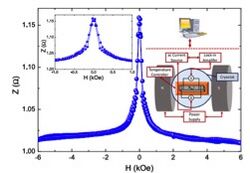Physics:Giant magnetoimpedance
In materials science Giant Magnetoimpedance (GMI) is the effect that occurs in some materials where an external magnetic field causes a large variation in the electrical impedance of the material. It should not be confused with the separate physical phenomenon of Giant Magnetoresistance.
The phenomenology of the GMI
GMI is caused by the penetration length that is a measure of how deep an ac electrical current can flow inside an electrical conductor. The penetration length (also known as the skin-depth effect) increases with the square root of the electrical resistivity of the material and is inversely proportional to the square root of the product of the magnetic permeability and the frequency of the ac electrical current. Thus, in materials with very high values of magnetic permeability, such as soft-ferromagnetic materials, the penetration-length can be much less than the thickness of the conductor even for moderate values of frequencies driving the current near the surface of the material.
When an external magnetic field is applied, the size of the permeability diminishes, increasing the penetration of the current in the magnetic material. Large variations are observed in both in-phase and out-of-phase components of the magnetoimpedance for applied magnetic fields close to the value of the Earth magnetic field up to few tens of Oersted. For comparison, in normal electrical conductors the effect of the skin-depth becomes important for frequencies in the microwave range only.
Despite the fact that the dependence of the GMI on the geometry of the electrical conductor (ribbons, wires, multilayers meander-likes) and external parameters is somewhat complex, there are theoretical models that allow calculation of the GMI to within some approximations.[1][2] Beside the dependence of the GMI on the frequency of the current there are other sources that contribute to the frequency dependence of the GMI, such as the motion of the domain wall and the ferromagnetic resonance.[3]
Experimental measurement
A typical experimental set-up for investigating the GMI in research laboratories is shown below. It includes an alternating current source, a phase sensitive amplifier for detecting the ac voltage across the sample and an electromagnet for applying a dc magnetic field. A cryostat or an oven may be required for measuring the temperature dependence of the GMI.[4]
Several experimental measurements were also performed to characterize the long-term stability and the thermal drift of the GMI, which were supported by a theoretical model describing the physical modeling of the sensing element.[5]
History
The observation that the impedance of soft-magnetic materials is influenced by the frequency and amplitudes of applied magnetic fields was first observed in the 1930s.[6][7] These initial studies were limited to frequencies of a few hundreds of Hz and the changes of impedance reported in those works were not large. Starting in the 1990s, this phenomenon was investigated again, this time making use of currents with frequencies of hundreds of kHz.[8]
Because of the huge variations observed in the magnetic field dependence of the magnetoimpedance it was named giant magnetoimpedance.[9] Due to the high sensitivity of the sensors using the GMI effect, they have been used in compasses, accelerometers, virus detection, biomagnetism, among other applications.[10][11][12]
References
- ↑ Machado (1996-04-15). "A theoretical model for the giant magnetoimpedance in ribbons of amorphous soft‐ferromagnetic alloys". Journal of Applied Physics 79 (8): 6558–6560. doi:10.1063/1.361945. ISSN 0021-8979. Bibcode: 1996JAP....79.6558M.
- ↑ Panina (1995-03-01). "Giant magneto-impedance in Co-rich amorphous wires and films". IEEE Transactions on Magnetics 31 (2): 1249–1260. doi:10.1109/20.364815. ISSN 0018-9464. Bibcode: 1995ITM....31.1249P.
- ↑ Machado (1999). "Surface Magnetoimpedance Measurements in Soft-Ferromagnetic Materials". Physica Status Solidi A 173 (1): 135–144. doi:10.1002/(SICI)1521-396X(199905)173:1<135::AID-PSSA135>3.0.CO;2-#. Bibcode: 1999PSSAR.173..135M.
- ↑ Ribeiro (2016-09-05). "GMI in the reentrant spin-glass Fe90Zr10 alloy: Investigation of the spin dynamics in the MHz frequency regime". Applied Physics Letters 109 (10): 102404. doi:10.1063/1.4962534. ISSN 0003-6951. Bibcode: 2016ApPhL.109j2404R.
- ↑ Esper (2020-08-15). "Theoretical and Experimental Investigation of Temperature-Compensated Off-Diagonal GMI Magnetometer and Its Long-Term Stability". IEEE Sensors Journal 20: 9046-9055. doi:10.1109/JSEN.2020.2988939. https://ieeexplore.ieee.org/document/9072377.
- ↑ HARRISON, E. P.; TURNEY, G. L.; ROWE, H. (1935). "Electrical Properties of Wires of High Permeability". Nature 135 (3423): 961. doi:10.1038/135961a0. Bibcode: 1935Natur.135..961H.
- ↑ Harrison, E. P.; Turney, G. L.; Rowe, H.; Gollop, H. (1936-11-02). "The Electrical Properties of High Permeability Wires Carrying Alternating Current" (in en). Proceedings of the Royal Society of London A: Mathematical, Physical and Engineering Sciences 157 (891): 451–479. doi:10.1098/rspa.1936.0208. ISSN 1364-5021. Bibcode: 1936RSPSA.157..451H.
- ↑ Machado (1994-05-15). "Giant ac magnetoresistance in the soft ferromagnet Co70.4Fe4.6Si15B10". Journal of Applied Physics 75 (10): 6563–6565. doi:10.1063/1.356919. ISSN 0021-8979. Bibcode: 1994JAP....75.6563M.
- ↑ Panina (1994-11-15). "Giant magneto‐impedance and magneto‐inductive effects in amorphous alloys (invited)". Journal of Applied Physics 76 (10): 6198–6203. doi:10.1063/1.358310. ISSN 0021-8979. Bibcode: 1994JAP....76.6198P.
- ↑ Knobel, M.; Vazquez, M.; Kraus, L. (2003). Buschow, K.H.J.. ed. Giant Magnetoimpedance in Handbook of magnetic materials. The Netherlands: Elsevier. pp. 497–564. ISBN 978-0-444-51459-2.
- ↑ Knobel, M.; Pirota, K. R. (2002-04-01). "Giant magnetoimpedance: concepts and recent progress". Journal of Magnetism and Magnetic Materials. Proceedings of the Joint European Magnetic Symposia (JEMS'01) 242–245, Part 1: 33–40. doi:10.1016/S0304-8853(01)01180-5. Bibcode: 2002JMMM..242...33K.
- ↑ Phan, Manh-Huong; Peng, Hua-Xin (2008-02-01). "Giant magnetoimpedance materials: Fundamentals and applications". Progress in Materials Science 53 (2): 323–420. doi:10.1016/j.pmatsci.2007.05.003.
 |



